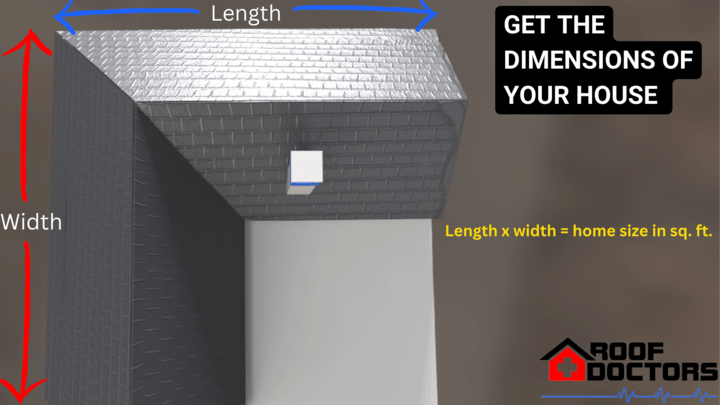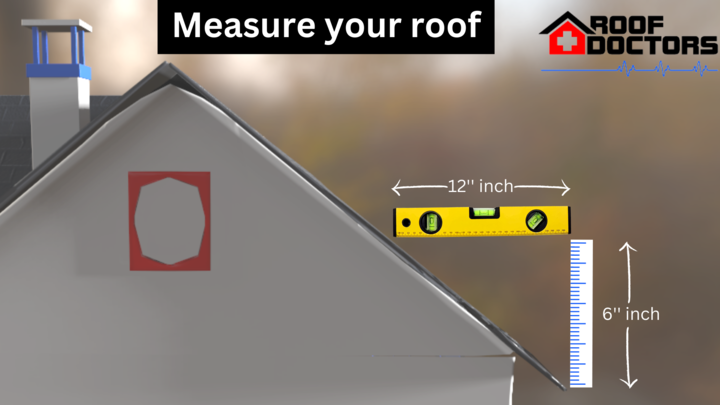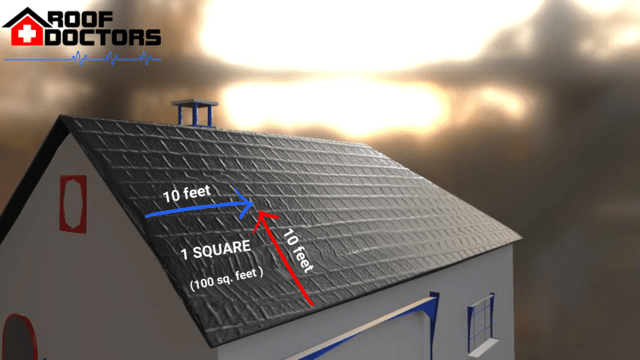You may have heard the term “roof square” used for roof repairs or replacements from your contractor or online. Some of you may be scratching your head, wondering if they meant a square foot, a ruler, a piece of the roof, or something else entirely.
Roofing queries like this are common ones for us at The Roof Doctor; we’re happy to answer them and assist with any roofing issues, no matter where you are. At the end of his piece, you’ll understand what a roofing square is and how it’s typically used in the roofing industry.
What is a roof square?
If you bring in the resources, you can build or repair a roof, but how do you know how much? Consequently, specialists utilize a “roof square” to calculate how much material is needed for your roof.
Roofing squares are the basic unit of measurement used by roofers to estimate the amount of time and materials needed to cover a specific area of the roof. What dimensions does a roofing square represent?
How big is a roof square?
A roofing square is a 10×10 area with a roof surface area of 100 square feet. Roofing projects cost more as the number of roofing squares grows.
When determining the cost of materials, labor, and the total amount of materials needed, it is crucial to know how many bundles of roofing material it takes to fill a roofing square. For example, to cover a square, you might use three bundles of shingles.
Some property owners prefer to read the cost breakdown in square footage instead of roofing square, which might cause confusion. Depending on the unit of measurement, a simple division by 100 or multiplication by 100 will do the trick.
Why use the roof square measurement?
Maybe you’re asking why we’re using this simplistic measurement when we could just as easily use yards or linear square feet. It comes down to the ease of communication between suppliers of roofing materials and installers of those materials by means of a universally accepted unit of measurement.
Roofing materials such as shingles and roofing tiles are prefabricated in a variety of sizes that are all designed to fit within a standard roofing square, so the measurement remains the same. Evidently, this is much more convenient to work with than square feet or yards.
While the roofing square may be useful for your own roofing projects, it is recommended that you consult a professional before making any major choices. Though you might be sure of your ability to predict what supplies you’ll need, it’s still smart to take some safety measures first.
How is a roof square used in the roofing industry?
When the roofer says your roof has 20 squares, what does it mean? You may get the total squares by dividing the square footage of your roof by 100. The area in question is 2000 square feet.
After measuring the length and width of each plane on your roof, roofers multiply those values to determine how many roofing squares would be needed for the project.
A gable roof, one of the simplest types of roof, will have two planes, one at the front of the house and the other at the back. Depending on the design, some roof types may have more.
A contractor can calculate the total number of squares once they have the square footage of all the planes. The entire amount of materials required typically includes a 10%-15% buffer for waste cover, such as trim wastage.
You now have a better understanding of a roofing square. What if you could find out how much a new roof will cost you per square before taking the plunge?
3 steps to calculate the square footage of your roof
If you want to do everything by yourself, we can help you make a ballpark estimate of how much your project will cost by using an easy-to-use method for determining the square footage of your roof. However, if you want a precise estimate, you should have a professional roofer in your area take measurements.
1. Get the dimensions of your house

Your roof’s square footage can only be estimated with some precision using your home’s total square footage. For this reason, it is important to calculate the size of your house while keeping a few things in mind.
- Find a sturdy ladder and double-check its stability before attempting any sort of measurement so that you won’t have to worry about slipping off the roof as you make your way up there. Wearing traction-enhancing footwear, such as work boots, is mandatory after you reach the roof.
- People often make the mistake of not measuring something thoroughly before placing an order for it. Mismeasurement might result in significantly higher roofing material costs, making this a key step before placing any orders. Measure twice; order once!
You can measure the perimeter of your house using your stride (somewhere between 2 to 2.5 feet) or using a measuring tape. If you use your stride, count the number of strides along and across your home, then multiply the two values to get your home’s footprint.
Length x width = your home’s size in sq. ft.
The perimeter of your home can be calculated using either your stride (often between 2 and 2.5 feet) or a measuring tape. If you want to calculate your home’s footprint using a stride, you need to count the number of strides along and across your house and then multiply those numbers together.
Even while you won’t be able to get an accurate number, this measuring method can provide a rough sketch of your house’s size. It’s important to keep in mind that the space under a roof is not the same as the space under a floor, which is why we move on to the next step.
2. Account for Pitch

The next step is to inspect your roof and determine whether or not it has a low, medium, or high pitch. The slope and complexity of your roof should be accounted for when determining the total square footage.
You’ll need a different factor to account for the roof’s steepness and complexity. This is the toughest and most difficult component of taking your own roof measurements.
We advise against attempting this on your own and instead suggest you get in touch with experts like us. To begin with, let’s talk about safety. If your roof has a steep slope, you should use a strong ladder and a harness, if one is available.
The rise over run equation can be used to calculate the roof’s pitch with ease; the rise represents the roof’s vertical component, while the run describes its horizontal extent. You may easily calculate the pitch of your roof by understanding that for every foot (or run) it extends horizontally, it rises by “x” number of inches.
Use your measuring tape to take a horizontal measurement at the height of 1 foot from the rafter base. Make an “L” with the level’s end at the 1-foot mark.
Once the bubble of air in the level is in the center, the height is determined by measuring from the base of the level to the ridge of the roof. A roof with a “rise” of 5 inches has a pitch of 5/12, meaning that for every 12 inches of horizontal length, the roof rises up 5 inches.
3. Calculate the total square footage of your roof with the pitch factor
After carefully measuring the span of your roof and accounting for its pitch and complexity, you can move on to learning how to determine its square footage. This equation may help you determine the approximate square footage of your roof:
Length of house x width of house = (size of your home sq. Ft.)
(House size sq. Ft.) x (pitch factor) = (roof area in square feet)
Multiplying the roof area by the roof pitch conversion factor or roof pitch multiplier approximates the roof’s total surface area. The following table shows various roof pitches and their roof pitch factors.
| Roof Pitch | Angle | Roof Pitch Factor |
| 1/12 | 4.76° | 1.0035 |
| 2/12 | 9.46° | 1.0138 |
| 3/12 | 14.04° | 1.0308 |
| 4/12 | 18.43° | 1.0541 |
| 5/12 | 22.62° | 1.0833 |
| 6/12 | 26.57° | 1.1180 |
| 7/12 | 30.26° | 1.1577 |
| 8/12 | 33.69° | 1.2019 |
| 9/12 | 36.37° | 1.2500 |
| 10/12 | 39.81° | 1.3017 |
| 11/12 | 42.51° | 1.3566 |
| 12/12 | 45.00° | 1.4142 |
Example:
If your house is 60 feet long and 30 feet wide and has an easily accessible gable roof, the computation would look something like this:
- The dimensions are 60 feet in length by 30 feet in width, for a total of 1800 feet (the size of your home)
60 x 30 = 1800
- Multiplying 1800 by 1.3 (the height of a standard gable roof, which may be climbed easily) yields 2,340 feet (square feet of roof area)
1800x 1.3 = 2,340
The roof area can be approximated by multiplying the squares by a conversion factor. Easily the most straightforward step, you should divide the total square footage by 100 to get the number of squares of roofing material you’ll need.
Although this formula isn’t foolproof, knowing the area of your roof will give you a good idea of how much money you’ll need to spend on a new one. Congratulations! You can now calculate the amount of roofing material required.
What else affects the price of your new roof?
You may now use the roofing square measurement to estimate the number of roofing materials you’ll need for your project. A roofing calculator can estimate how much it will cost to replace or repair your roof.
It is important to keep in mind that the square footage of your roof is a significant factor in determining the total cost of the replacement. However, to obtain a full image of what goes into the scope of your investment, you need to be aware of the other key factors that affect the cost of your new roof.
The cost of a new roof can be substantial; therefore, we want all of our customers to be well-informed. The price of roofing services in your area may be affected by a variety of factors, including:
- Availability of roofing materials
- Availability of roofing labor
- The scope of the work involved
- Time of the year
- The type and quality of roofing materials
- The workmanship of the hired company
FAQ
The local community has benefited from The Roof Doctor’s knowledge and years of experience in the roofing sector ever since the company was founded in 1987. Taking measures of our roof is an activity that requires a lot of time and comes with some inherent risk, as we have already demonstrated.
Because many things could go wrong, it is generally best to let the professionals handle it instead of doing it yourself. Our staff members have extensive training and are insured.
When it comes to problems with your roof, such as determining the amount of roofing material required for a specific job, we will also be available to assist you in any way we can. If you require assistance with measuring your roof, get in touch with us today!


